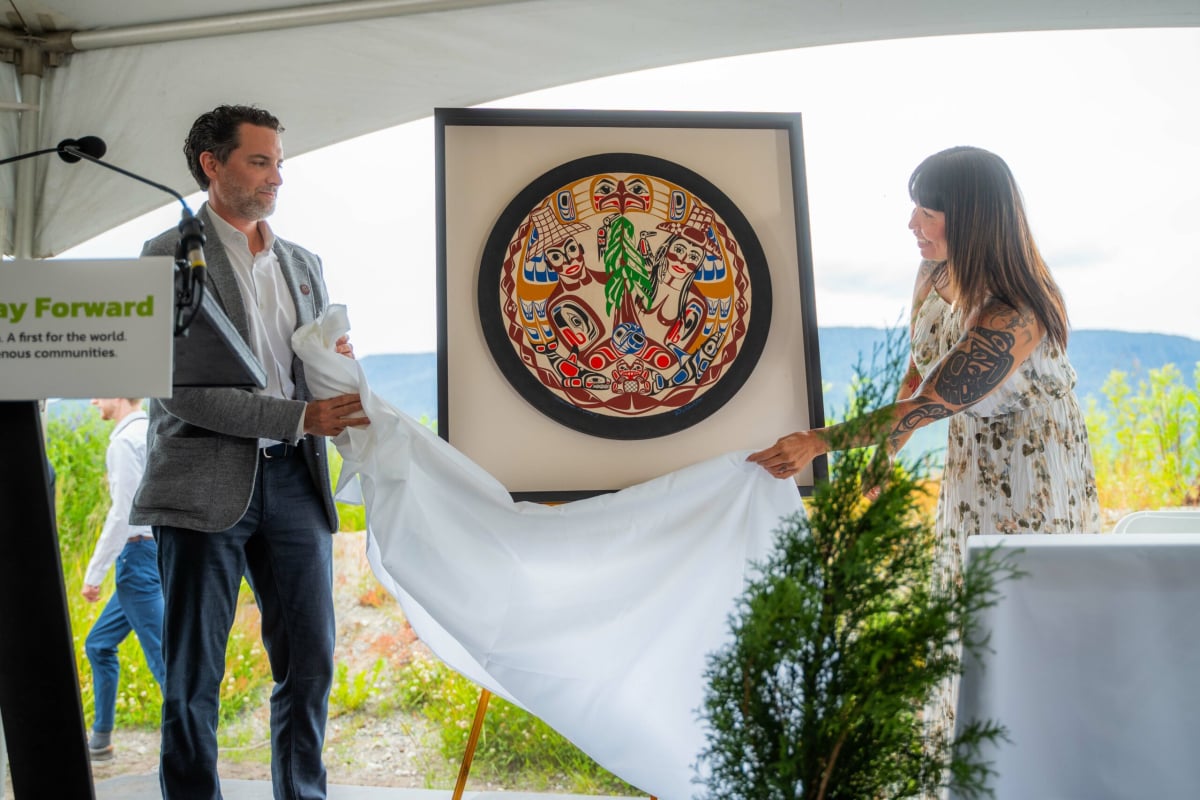Support strong Canadian climate journalism for 2025
Canada’s Crown corporation dedicated to helping industries export overseas, has confirmed up to $500 million will be financed for a First Nation-led LNG project in British Columbia.
This week, Export Development Canada (EDC) said it will provide a loan to Cedar LNG, based in Kitimat, B.C., of between $400 and $500 million as part of a wider lending group. EDC only provides dollar ranges, not a specific amount, to "protect the confidentiality and commercial sensitivity of our customers, as outlined in our policy," the department told Canada's National Observer.
The loan will support development of the project and the “associated onshore infrastructure,” EDC told Canada’s National Observer in a statement.
The EDC loan represents a key piece of the financing puzzle that is now solved for Cedar LNG. The project has also secured a construction term loan with a “syndicate of banks” at a favourable rate for around 60 per cent of the approximately $4-billion project cost.
Cedar LNG is led by the Haisla nation, a majority owner of the project with a 50.1 per cent stake. The nation has partnered with Pembina Pipeline Corp. for the project that will be a floating LNG facility with a capacity for 3.3 million tonnes of gas a year. It is expected to be in service by late 2028.
The Haisla have praised the project as a pathway to prosperity and self-reliance, pointing to its ability to fund the First Nation’s social services and cultural programs without depending on federal payments.
“It’s the first project of its kind: Indigenous-led, majority Indigenous-owned, essentially trailblazing a path to economic independence,” Crystal Smith, Chief Councillor for the Haisla Nation said in a video released Tuesday.
Indigenous entry into fossil fuel development remains controversial. Supporters, such as resource development organizations like the First Nation Major Project Coalition, argue that equity stakes provide economic justice after decades of resource extraction on their lands. Critics point to the realities of capitalism and colonialism for entrenching Indigenous nations in economic dependency on Ottawa.
Meanwhile, environmentalists are dismayed by the decision and point to subsidies for yet another fossil fuel project as a broken commitment from Ottawa.
Julia Levin, associate director for Environmental Defence, says federal subsidies to a new fossil fuel project is “disappointing to see” given the Liberal government’s promise to phase them out. Levin called the subsidy phaseout commitment a “no-brainer,” when “we are in a climate emergency that is killing people in Canada, around the world each and every day,” she said.
“You have to stop funding the very source of the problem,” Levin added.
According to Clean Energy Canada, Cedar LNG is also estimated to generate over nine million tonnes of climate pollution annually, with approximately eight million tonnes emitted after the gas reaches its market, otherwise known as “downstream” emissions. Another one million tonnes of carbon is projected at the facility and sent to the facility, otherwise known as “upstream” emissions.
However, in the commitment to phase out fossil fuel subsidies, Ottawa left a back door open if they support economic reconciliation. It's a back door reinforced earlier this year when the federal Indigenous loan guarantee program was developed as “sector agnostic.”
“A key priority for (Export Development Canada) is to support Indigenous economic reconciliation by supporting Indigenous businesses as they pursue economic self-reliance and growth through exporting, and we recognize that Canada’s natural resources industries provide strong opportunities to do so,” an EDC statement to Canada’s National Observer said.
However, there are also concerns that new fossil fuel projects like Cedar LNG could become stranded assets in a world market increasingly investing in alternative energy and fuels, such as electrification.
The International Energy Agency estimates that natural gas demand will peak in 2030, two years after Cedar LNG comes online. However, it’s unclear how quickly demand will drop over the next several years.
In a Wednesday letter to Environmental Defence, EDC said it “understands the urgency in taking climate action” and is committed to a “low carbon economy.” The letter highlights B.C.’s hydroelectricity, which will power the LNG facility, making the project “one of the world’s lowest greenhouse gas emissions natural gas operations.”
But Levin is not buying it: “To say you're the cleanest LNG is like saying I'm the healthiest cigarette. A fossil fuel is a fossil fuel.”
With federal financing for Cedar LNG secured, all eyes now turn to the Ksi Lisims LNG, led by the Nisga’a and their industry partners. Ksi Lisims is still waiting for the provincial approval on their environmental assessment later this year. Once approved, the project will examine its final investment decision.
B.C. Premier David Eby celebrated the financing of Cedar LNG, lauding the project as a “true partnership” between First Nations and the provincial government. Meanwhile, Trudeau noted that the Haisla will now manage its own revenue stream: "revenue to build up your community, for your members on your terms.”
Matteo Cimellaro / Canada’s National Observer / Local Journalism Initiative
Due to a typographical error, a previous version of this article stated that Cedar LNG's project cost was $40 billion. In fact, the project cost is $4-billion.







Comments
Meanwhile, other First Nations are partnering with wind and solar companies to build industrial scale renewables on their lands to export to the grid in several provinces, and with a far shorter timeline to completion.
Which of these will have a better long term return on the investments given the world transition from fossil fuels to electricity is well underway? Fresh data from Germany indicate the momentum toward renewables, especially decentralized rooftop solar, has pushed several fossil gas peaker plants into closure at an unprecedented rate years in advance of the latest estimates.
Stranded LNG assets are nearly guaranteed, even before the equipment is broken in and barely after the paint has dried. Just who will pay the debt and decommisioning costs then, let alone for cleanup?
How is it possible to start planning for the future when all the eggs were placed in one basket, and when the economic feasibility studies on LNG failed so miserably in basic research of world energy trends?
I feel that the first nation backing this project is selling out the land they love and all of the natural world. That is not the good stewardship that most First Nations practice.